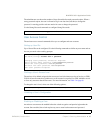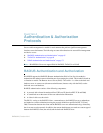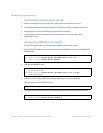
BLADEOS 6.5.2 Application Guide
BMD00220, October 2010 Chapter 4: Authentication & Authorization Protocols 69
TACACS+ Authentication
BLADEOS supports authentication and authorization with networks using the Cisco Systems
TACACS+ protocol. The G8124 functions as the Network Access Server (NAS) by interacting with
the remote client and initiating authentication and authorization sessions with the TACACS+ access
server. The remote user is defined as someone requiring management access to the G8124 either
through a data port or management port.
TACACS+ offers the following advantages over RADIUS:
TACACS+ uses TCP-based connection-oriented transport; whereas RADIUS is UDP-based.
TCP offers a connection-oriented transport, while UDP offers best-effort delivery. RADIUS
requires additional programmable variables such as re-transmit attempts and time-outs to
compensate for best-effort transport, but it lacks the level of built-in support that a TCP
transport offers.
TACACS+ offers full packet encryption whereas RADIUS offers password-only encryption in
authentication requests.
TACACS+ separates authentication, authorization and accounting.
How TACACS+ Authentication Works
TACACS+ works much in the same way as RADIUS authentication as described on page 65.
1. Remote administrator connects to the switch and provides user name and password.
2. Using Authentication/Authorization protocol, the switch sends request to authentication server.
3. Authentication server checks the request against the user ID database.
4. Using TACACS+ protocol, the authentication server instructs the switch to grant or deny
administrative access.
During a session, if additional authorization checking is needed, the switch checks with a
TACACS+ server to determine if the user is granted permission to use a particular command.


















